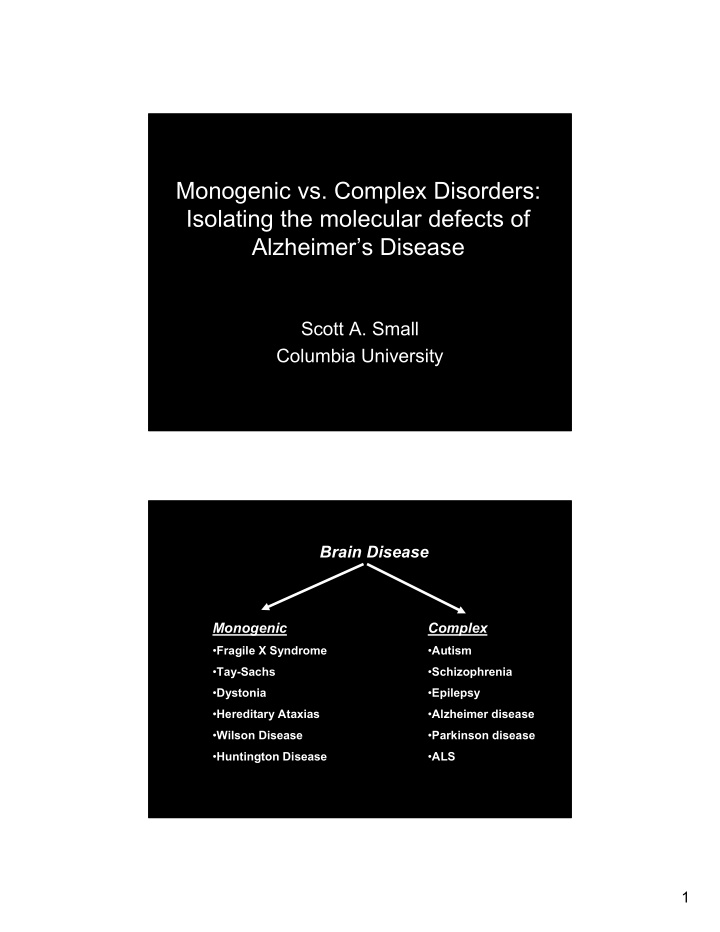



Monogenic vs. Complex Disorders: Isolating the molecular defects of Alzheimer’s Disease Scott A. Small Columbia University Brain Disease Monogenic Complex • Fragile X Syndrome • Autism • Tay-Sachs • Schizophrenia • Dystonia • Epilepsy • Hereditary Ataxias • Alzheimer disease • Wilson Disease • Parkinson disease • Huntington Disease • ALS 1
Alzheimer Disease Monogenic Complex • Early Onset Alzheimer • Late-Onset Alzheimer Disease (EOAD) Disease (LOAD) • Familial • Sporadic • 5% • 95% EOAD LOAD Anatomy 2
Pathophysiology Small SA, Nature Neuroscience, 2005 Histology 3
Histology soluble insoluble Amyloid A β peptide Plaques Tau protein Neurofibrillary Tangles Molecular & Cell Biology Gamma BACE APP secretase A β β -cleavage γ -cleavage TGN Endosome ER Lysosome NUC A β A β A β 4
Molecular Defects in Monogenic Disorders Molecular Techniques: Statistical Models: Large-Scale Genetic Profiles Pinpointing Genetic Defect Single Nucleotide Polymorphisms (SNPS) 1. Law of "Segregation of Characteristics.“ 2. Law of "Independent Assortment". Molecular Defects in Early-Onset AD APP(ch21q21.3) Presenilin1 (ch14q24.13) Presenilin2 (ch1q31.42) 5
Molecular Defects in Late-Onset AD Apolipoprotein E (APOE): ε 2, ε 3, ε 4 (ch19q13.2) Roberts JS, et al, J Geriatr Psychiatry Neurol, 2005 Region A Region B Genes Genes Brain Cells Gene Products Gene Products Genes Genes Liver Cells Gene Products Gene Products 6
Healthy Alzheimer’s Disease Genes Genes Gene Products Gene Products Twin A Twin B Molecular Defects in Complex Disorders Molecular Techniques: Statistical Models: Large-Scale Genetic Expression Profiles Pinpointing Molecular Defects Microarray 7
Spatial Information Expression Level control control control Pt 1 Pt 1 Pt 1 Pt 2 Pt 2 Pt 2 Pt 3 Pt 3 Pt 3 control control control Pt 1 Pt 1 Pt 1 Pt 2 Pt 2 Pt 2 Pt 3 Pt 3 Pt 3 control control Pt 1 Pt 1 Pt 2 Pt 2 Pt 3 Pt 3 control control control Pt 1 Pt 1 Pt 1 Pt 2 Pt 2 Pt 2 Pt 3 Pt 3 Pt 3 Temporal Information Spatial Information CA3 DG SUB CA1 EC 8
Spatial Information Temporal Information CA3 DG SUB CA1 EC Retromer Trafficking Annals of Neurology, 2005 VPS29 SNX1/ VPS35 2 VPS26 TGN Endosome TGN Endosome Retromer Dysfunction Normal Retromer Function (VPS35, VPS26 knock-down) 9
A. Manipulate molecules B. Manipulate molecules C. Test for polymorphisms A β levels Memory loss, synaptic Risk for developing Alzheimer’s disease dysfunction, A β levels Annals of Neurology, 2005 Abeta levels % 160 120 Abeta levels 140 100 Cell 120 80 100 80 60 Culture 60 % 40 40 20 20 0 VPS35 siRNA 0 Non-silencing control Empty vector control VPS35 transfection APP/BACE Retromer-Deficient Hippocampal-Dysfunction Increased endogenous A β Retromer Cargo Co-Localization VPS26 levels 12 12 VPS26 8 Memory 12 12 A β 40 A β 40 10 10 10 10 VPS26 levels (normal) VPS26 levels (normal) 6 8 8 8 8 ls ls SNX1/2 E rro rs e e VPS29 W Mouse 6 6 v v 6 6 4 e e L L VPS35 T 4 4 4 4 Models 2 2 2 2 2 VPS26 0 0 0 0 KO wildtype WT mutant 0 WT WT KO KO WT KO 1 2 3 4 30 minute delay Trials 1. APP VPS35 levels VPS35 1.8 1.8 6 6 A β 42 A β 42 2. Sorla 1.6 1.6 VPS35 levels (normal) VPS35 levels (normal) 4 4 CT (BACE) Levels Levels 1.4 1.4 3. Sortilin 2 2 1.2 1.2 (BACE) 1 1 siRNA KO WT 0 0 wildtype knockdown WT WT KO KO sorLA sortilin Risk for Late-Onset Human SNX1/ VPS2 2 9 VPS35 Alzheimer’s Disease Disease VPS26 Nature Genetics, Under Review 10
Annals of Neurology, 2005 Molecular Defects in Complex Disorders Molecular Techniques: Statistical Models: Large-Scale Genetic Expression Profiles Pinpointing Molecular Defects Functional Imaging Microarray 11
12
Recommend
More recommend